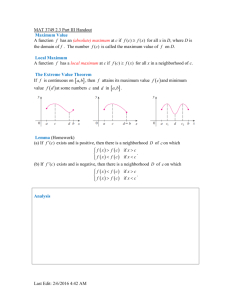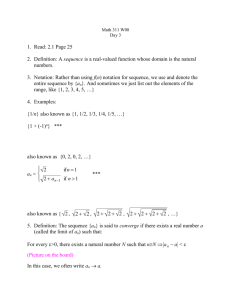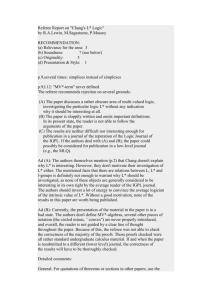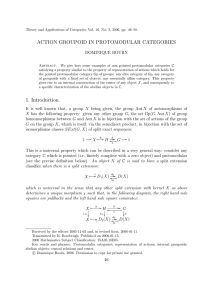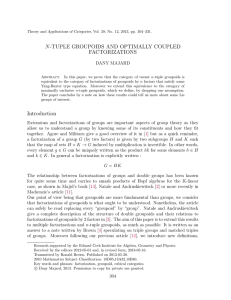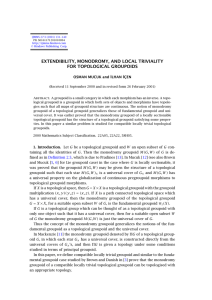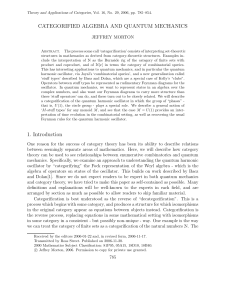paper shabani1
advertisement
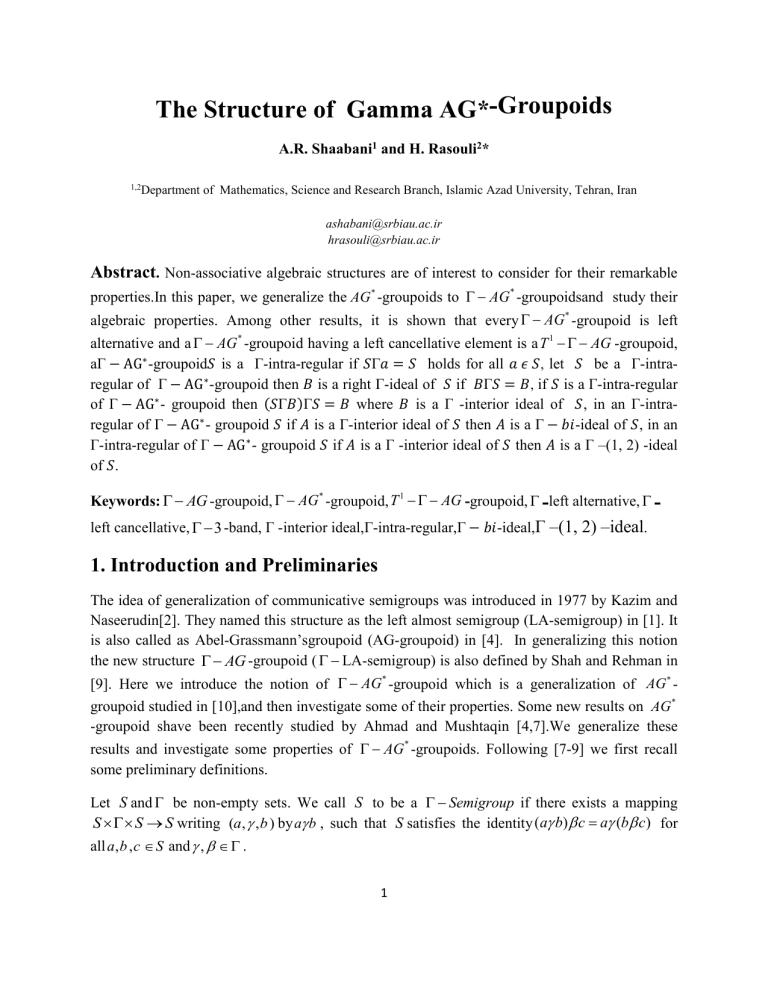
The Structure of Gamma AG*-Groupoids A.R. Shaabani1 and H. Rasouli2* 1,2 Department of Mathematics, Science and Research Branch, Islamic Azad University, Tehran, Iran ashabani@srbiau.ac.ir hrasouli@srbiau.ac.ir Abstract. Non-associative algebraic structures are of interest to consider for their remarkable properties.In this paper, we generalize the AG * -groupoids to AG * -groupoidsand study their algebraic properties. Among other results, it is shown that every AG * -groupoid is left alternative and a AG * -groupoid having a left cancellative element is a T 1 AG -groupoid, aΓ − AG∗ -groupoid𝑆 is a Γ-intra-regular if 𝑆Γ𝑎 = 𝑆 holds for all 𝑎 𝜖 𝑆, let 𝑆 be a Γ-intraregular of Γ − AG∗-groupoid then 𝐵 is a right Γ-ideal of 𝑆 if 𝐵Γ𝑆 = 𝐵, if 𝑆 is a Γ-intra-regular of Γ − AG∗ - groupoid then (𝑆Γ𝐵)Γ𝑆 = 𝐵 where 𝐵 is a Γ -interior ideal of 𝑆, in an Γ-intraregular of Γ − AG∗ - groupoid 𝑆 if 𝐴 is a Γ-interior ideal of 𝑆 then 𝐴 is a Γ − 𝑏𝑖-ideal of 𝑆, in an Γ-intra-regular of Γ − AG∗ - groupoid 𝑆 if 𝐴 is a Γ -interior ideal of 𝑆 then 𝐴 is a Γ –(1, 2) -ideal of 𝑆. Keywords: AG -groupoid, AG * -groupoid, T 1 AG -groupoid, -left alternative, left cancellative, 3 -band, Γ -interior ideal,Γ-intra-regular,Γ − 𝑏𝑖-ideal,Γ –(1, 2) –ideal. 1. Introduction and Preliminaries The idea of generalization of communicative semigroups was introduced in 1977 by Kazim and Naseerudin[2]. They named this structure as the left almost semigroup (LA-semigroup) in [1]. It is also called as Abel-Grassmann’sgroupoid (AG-groupoid) in [4]. In generalizing this notion the new structure AG -groupoid ( LA-semigroup) is also defined by Shah and Rehman in [9]. Here we introduce the notion of AG * -groupoid which is a generalization of AG * groupoid studied in [10],and then investigate some of their properties. Some new results on AG * -groupoid shave been recently studied by Ahmad and Mushtaqin [4,7].We generalize these results and investigate some properties of AG * -groupoids. Following [7-9] we first recall some preliminary definitions. Let S and be non-empty sets. We call S to be a Semigroup if there exists a mapping S S S writing (a, , b ) by a b , such that S satisfies the identity (a b) c a (b c) for all a , b , c S and , . 1 A Semigroup with identity is called a -monoid. Let S and be non-empty sets. We call S to be a AG -groupoid if there exists a mapping S S S writing (a, , b ) by a b such that satisfies the identity a b c c b a for all a , b , c S and , . An element e S is called a left identity if e a a for all a S and . A AG -groupoid S is called: (i) - medial if for every a , b , c , d S and , , a b c d ac b d . (ii) -paramedial if for every a, b, c , d S and , , ab c d d b c a . (iii) - locally associative if for every a S and , it satisfies (a a) a a (a a) . (iv) -idempotent if for every a S and , a a a . In the following we recall the definitions from [4] which are applied in this paper. Definition 1.1.A AG -groupoid S is called a AG - band if every its element it idempotent. Definition 1.2.A AG -groupoid is called a T 1 AG -groupoid if for every a , b , c , d S , , a b c d implies b a d c . Definition 1.3.A AG -groupoid S is called a AG 3 -band if a (a a) (a a) a a , for all a S and , . Definition 1.4.A AG -groupoid S is called a -left alternative if for all a, b S and , , (a a ) b a (a b ) . Definition 1.5. A AG -groupoid S is called a -left cancellative if for every a , b , c S and , ab ac implies b c . Definition 1.6. An element 𝑎 of a Γ − AG -groupoid 𝑆 is called a Γ-intra-regular if there exists 𝑥, 𝑦 𝜖 𝑆 and 𝛼, 𝛽, 𝛾 𝜖 Γ such that 𝑎 = (𝑥𝛼 (𝑎𝛽𝑎))𝛾𝑦 and 𝑆 is called a Γ – intra- regular Γ − AG − groupoid S, if every element of 𝑆 is an Γ-intra- regular. Definition 1.7. A Γ − 𝐴𝐺-subgroupoid 𝐴 from a Γ − 𝐴𝐺-groupoid 𝑆 is called a Γ – interior ideal of 𝑆 if (𝑆Γ𝐴)Γ𝑆 ⊆ 𝐴. 2 Definition 1.8. A Γ − 𝐴𝐺-subgroupoid 𝐴 from a Γ − 𝐴𝐺-groupoid 𝑆 is called a Γ – bi-ideal of 𝑆 if (𝐴Γ𝑆)Γ𝐴 ⊆ 𝐴. Definition 1.9. A Γ − 𝐴𝐺-subgroupoid 𝐴 from a Γ − 𝐴𝐺-groupoid 𝑆 is called a Γ –(1,2)- ideal of 𝑆 if (𝐴Γ𝑆)Γ𝐴2 ⊆ 𝐴. We recall the three following lemmas from [8] which are applied to get some results. Lemma 1.10.Every AG -groupoid is -medial. Lemma 1.11.Every AG -groupoid with left identity is -paramedial. Lemma 1.12.In an AG -groupoid S with left identity, we have a (b c ) b (a c ) for every a , b , c S and , . Lemma 1.13. Let 𝑆 be a Γ − AG -groupoid with left identity 𝑒 then, 𝑆Γ2 = 𝑆Γ𝑆 = 𝑆 and 𝑆Γ𝑒 = 𝑒Γ𝑆 = 𝑆. 2. On AG -groupoids * In this section we introduce the notion of AG * -groupoid which is a generalization of AG * groupoid studied in [10],and then investigate some of their properties. An AG -groupoid S is called an AG * -groupoid if it satisfies the identity (ab )c b (ac ) for all a, b , c S . Definition 2.1. A AG -groupoid S is called a AG * -groupoid if it satisfies the identity (a b ) c b (a c) for all a , b , c S and , . Example 2.2. Let S be an arbitrary AG * - groupoid and any non-empty set. Define a mapping S S S ,by a b ab for all a, b S and .Then S is a AG -groupoid (see [6]). Also for every a , b , c S and , we have (a b )c ab c ab c b (ac ) . On the other hand, b (a c ) b (ac ) b (ac ) . Hence, (a b ) c b (a c ) and then S is a AG * -groupoid. Example 2.3. Let S be an arbitrary AG * - groupoid and a fixed element in . We define a b a b for every a, b S . Then S , and , we have is an AG *-groupoid(see [6]).Also for every a , b , c S (a b ) c (a b ) c (a b ) c b (a c ) . On the other hand, b (a c ) b (a c ) b (a c ) . Hence, (a b ) c b (a c ) .Therefore, S is an AG * -groupoid. 3 Example 2.4. Let S be the set of all non-positive integers and be the set of all non-positive even integers. If a b denotes as usual multiplication of integers for a, b S and , then S is a AG * -groupoid but not an AG * -groupoid. Example 2.5. Let S be the set of all integers of the form 4n+1 where n is an integer and denote the set of all integers of the form 4n 3 . If a b is a b , for all a, b S and , then S is a AG * -groupoid but not an AG * -groupoid. Note that by Examples2.4 and 2.5, AG * -groupoids are a generalization of AG * -groupoids. Lemma 2.6. In every AG * -groupoid, we have b (a c ) b (c a ) for every a , b , c S and , . Proof. Let S be a AG * -groupoid. We have (a b ) c (c b ) a ,(by left invertive law) (a b) c b (a c) ,(by AG * -groupoid) (c b) a b (c a) ,(by AG * -groupoid) Then, b (a c ) b (c a ) . Lemma 2.7. In a AG -groupoid S with a left identity, we have a b a b for every a, b S and , . Proof. See [ 5 ]. Lemma 2.8. Every AG * -groupoid with a left identity is a commutative -semigroup. Proof. Let S be a AG * -groupoid with a left identitye. Then by Lemma2.6, we have b (a c ) b (c a ) for every a , b , c S and , . Now putting b e ,it follows that e (a c ) e (c a ) and then a c c a for commutative. Now since S is commutative, we obtain: (a b) c (b a) c (by commutativity) 4 every a , c S and . Therefore, S is a (b c ). (by AG * -groupoid) Hence, S is a -semigroup. Theorem 2.9. If a AG - band S contains a left identity e ,then S becomes a commutative monoid. Proof. See [ 5 ]. Proposition 2.10. Every T 1 AG -groupoid is paramedial. Proof. See [ 5 ]. Proposition 2.11. ([10]) If S is an AG * -groupoid, then for every x1 , x2 , x3 , x4 S , we have ( x1 x2 )( x3 x4 ) ( xP (1) xP (2) )( xP (3) xP (4) ) where P is any permutation on the set 1, 2,3, 4 . Notethat Proposition2.11 can be generalized for AG * -groupoids with left identity. As for AG * -groupoids without left identity we have: Proposition 2.12. If S is a AG * -groupoid, then for every x1 , x2 , x3 , x4 S and , , , ( x1 x2 ) ( x3 x4 ) ( x1 xP (2) ) ( xP (3) xP (4) ) where P is any permutation on the set 2,3, 4 . Proof. Let x1 , x2 , x3 , x4 be arbitrary elements of S . Then we have ( x1 x2 ) ( x3 x4 ) ( x1 x3 ) ( x2 x4 ) (by -medial law) ( x1 x3 ) ( x4 x2 ) (by Lemma 2.6) ( x1 x2 ) ( x4 x3 ) ( x1 x4 ) ( x2 x3 ) ( x1 x4 ) ( x3 x2 ) (by Lemma 2.6.and -medial law). Proposition 2.13. Let S be a AG * -groupoid. Then S is a commutative -semigroup if any of the following holds: i) ab c d a d bc ii) ab c d d a cb , for every a , b , c S and . Proof. Since for every a, b S and the equation ab ab trivially holds,an application of (i)or (ii) proves commutativity. So for every a , b , c S and , ,we get: 5 ab c b a c a c b b c a a b c . Hence, S is a commutative -semigroup. Lemma 2.14. If S is a AG * -band, then S S2 ,where S2 S S . Proof. By the definition of AG -groupoid we have S2 S S S . Let S be a AG * -band. For every x S , x x x S S for every . Therefore, S S S S2 . Hence, S S2 . 3. Some properties of AG * -groupoids In this section we investigate some properties important of AG * -groupoids. Proposition 3.1. Every AG * -groupoid is a left alternative . Proof. Let S be a AG * -groupoid and let a , b , c S and , . Then by the definition of AG * -groupoid we have a b c b a c (1). Now replacing b by a in (1), we have a a c a a c . Hence, S is a left alternative . Theorem 3.2. A AG * -groupoid S having a left cancellative element is T 1 AG groupoid. Proof. Let x be a left cancellative element of a AG * -groupoid S and a , b , c , d S , and , . Let ab c d . Then x b a b x a (by AG* -groupoid) a x b (by left invertive law) x (a b) (by AG * -groupoid) x (c d ) (by assumption) c x d (by AG* -groupoid) 6 d x c (by left invertive law) x (d c) (by AG * -groupoid) x (b a) x (d c) b a dc . (by left cancellative law) Hence,S is a T 1 AG -groupoid. Corollary 3.3. A AG * -groupoid S having a left cancellative element is paramedical. Proof. ByProposition2.10and Theorem3.2, the result is immediate. Proposition 3.4. Let S be a AG * -groupoid. If t S is a 3 -band, i.e. t t t t t t t for every , ,then t2 is a -idempotent, where t2 t t , . Proof. Let t S be a 3 -band. Then, t2 t2 (t t ) (t t ) t (t (t t )) (by AG* -groupoid) t t t2 . (by 3 -band) Hence, t2 is a -idempotent. Theorem 3.5. A AG * -groupoid S having a left cancellative square element is a T 1 AG -groupoid. Proof. Suppose x is a left cancellative square element of S and ab c d for every a , b , c , d S and , . Then it gives the following: x x b a (b x x ) a (by AG * -groupoid) ( x b x) a (by AG* -groupoid) (a x) ( x b) (by left invertive law) (a b) ( x x) (by Proposition 2.12) 7 (c d ) ( x x) (by assumption) (c x) ( x d ) (by Proposition 2.12) (( x d ) x) c (by left invertive law) (d ( x x)) c (by AG * -groupoid) ( x x) (d c) , (by AG * -groupoid) i.e. ( x x) (b a) ( x x) ( d c) b a dc . (by left cancellative law) Hence, S is a T 1 AG -groupoid. Proposition 3.6. Every T 1 AG -groupoid is paramedial. Proof. Let S be a T 1 AG -groupoid and let a , b , c , d S and , , . Now we have ab (c d ) ac (b d ) (by Lemma 1.6) (c d ) ab (b d ) ac (by T 1 AG -groupoid) (c d ) ab (b a) d c (by Lemma 1.6) ab (c d ) d c (b a) (by T 1 AG -groupoid) ab (c d ) d b (c a) .(by Lemma 1.6) Hence, S is paramedial. Corollary 3.7. Every left cancellative AG * -groupoid is paramedial Proof. By Proposition 2.10 and Theorem3.2, the result is immediate. Lemma 3.8. Let 𝑆 be a Γ − AG∗ -groupoid such that 𝑆Γ𝑎 = 𝑆, hold for all 𝑎 𝜖 𝑆 , then 𝑎Γ𝑆 = 𝑆 and 𝑆Γ𝑆 = 𝑆. Proof: Since 𝑆Γ𝑎 = 𝑆 for all 𝑎 = 𝜖 𝑆 then 𝑆Γ𝑆 = 𝑆, 𝑆 = 𝑆Γ𝑆 = (𝑆Γ𝑎)Γ𝑆 = 𝑎Γ(𝑆Γ𝑆) = 𝑎Γ𝑆.Hence 𝑎Γ𝑆 = 𝑆. 8 Theorem 3.9. A Γ − AG∗ -groupoid 𝑆 is a Γ-intra-regular if 𝑆Γ𝑎 = 𝑆 holds for all 𝑎 𝜖 𝑆. Proof: Since 𝑆Γ𝑎 = 𝑆 by lemma (2) 𝑆Γ𝑆 = 𝑆. Let 𝑎 𝜖 𝑆, then 𝑆 = 𝑆Γ(𝑆Γ𝑆) = (𝑆Γ𝑎)Γ((𝑆Γ𝑎)Γ𝑆)(𝑏𝑦 𝑎𝑠𝑠𝑢𝑚𝑝𝑡𝑖𝑜𝑛) (𝑏𝑦 Γ − 𝐴𝐺 ∗ − 𝑔𝑟𝑜𝑢𝑝𝑜𝑖𝑑) = ((𝑆Γ𝑎)Γ(𝑆Γ𝑎))Γ𝑆 (𝑏𝑦 𝑚𝑒𝑑𝑖𝑎𝑙 𝑙𝑎𝑤) = ((𝑆Γ𝑆)Γ(𝑎Γ𝑎))Γ𝑆 = (𝑆Γ𝑎Γ2 )Γ𝑆 Hence 𝑎 𝜖 (𝑆Γ𝑎Γ2 )Γ𝑆, i.e. 𝑆 is Γ-intra-regular. Theorem 3.10. Let 𝑆 be aΓ-intra-regular of Γ − AG∗-groupoid, then 𝐵 is a right Γ-ideal of 𝑆 if 𝐵Γ𝑆 = 𝐵. Proof: let 𝐵 is a right Γ-ideal i.e. 𝐵Γ𝑆 ⊆ 𝐵. Now let 𝑏 𝜖 𝐵, then by assumption there exists 𝑥, 𝑦 𝜖 𝑆 𝑎𝑛𝑑 𝛼, 𝛽, 𝛾 𝜖 Γ such that (𝑏𝑦 Γ – 𝑖𝑛𝑡𝑟𝑎 − 𝑟𝑒𝑔𝑢𝑙𝑎𝑟) 𝑏 = (𝑥𝛼(𝑏𝛽𝑏))𝛾𝑦 (𝑏𝑦 Γ − 𝐴𝐺 ∗ − 𝑔𝑟𝑜𝑢𝑝𝑜𝑖𝑑) = (𝑏𝛽𝑏) 𝛼 (𝑥𝛾𝑦) 𝜖 𝐵Γ𝑆 implies 𝐵 ⊆ 𝐵Γ𝑆. Hence 𝐵Γ𝑆 = 𝐵. Inverts is obviously. Theorem 3.11. If 𝑆 is a Γ-intra-regular of Γ − AG∗ - groupoid then (𝑆Γ𝐵)Γ𝑆 = 𝐵, where 𝐵 is a Γ -interior ideal of 𝑆. Proof: Since 𝐵 is a Γ-interior ideal of 𝑆also (𝑆Γ𝐵)Γ𝑆 ⊆ 𝐵, let 𝑏 𝜖 𝐵, we have (𝑏𝑦 Γ – 𝑖𝑛𝑡𝑟𝑎 − 𝑟𝑒𝑔𝑢𝑙𝑎𝑟) 𝑏 = (𝑥𝛼(𝑏𝛽𝑏))𝛾𝑦 (𝑏𝑦 Γ − 𝐴𝐺 ∗ − 𝑔𝑟𝑜𝑢𝑝𝑜𝑖𝑑) = ((𝑏𝛼𝑥)𝛽𝑏)𝛾𝑦 Since 𝛽 ⊆ 𝑆imples 𝑏𝛼𝑥 𝜖 𝑆. Hence 𝑏 𝜖 (𝑆Γ𝐵)Γ𝑆. Theorem 3.12. In an Γ-intra-regular of Γ − AG∗ - groupoid 𝑆, if 𝐴 is a Γ -interior ideal of 𝑆 then 𝐴 is a Γ – (1, 2) -ideal of 𝑆. Proof: let 𝐴 be a Γ-interior ideal of 𝑆, i.e. (𝑆Γ𝐴)Γ𝑆 ⊆ 𝐴. Let 𝜌 𝜖 (𝐴Γ𝑆)Γ(𝐴Γ𝐴), then 𝜌 = (𝑎𝜇𝑠)𝜃(𝑏𝛼𝑐) for some 𝑎, 𝑏, 𝑐 𝜖 𝐴, 𝑠 𝜖 𝑆 and 𝜇, 𝜃, 𝛼 𝜖 Γ. Since 𝑆 is Γ-intra-regular so there exists 𝑥, 𝑦 𝜖 𝑆 and 𝛽, 𝛾, 𝛿 𝜖 Γ such that 𝑎 = (𝑥𝛽 (𝑎𝛿𝑎))𝛾𝑦. Now we have 9 (𝑏𝑦 Γ − 𝑙𝑒𝑓𝑡 𝑖𝑛𝑣𝑒𝑟𝑡𝑖𝑣𝑒) 𝜌 = (𝑎𝜇𝑠)𝜃(𝑏𝛼𝑐) = ((𝑏𝛼𝑐)𝜇𝑠)𝜃𝑎 = ((𝑏𝛼𝑐)𝜇𝑠)𝜃 ((𝑥𝛽(𝑎𝛿𝑎))) 𝛾𝑦 (𝑏𝑦 Γ – 𝑖𝑛𝑡𝑟𝑎 − 𝑟𝑒𝑔𝑢𝑙𝑎𝑟 ) = (𝑥𝛽(𝑎𝛿𝑎))𝜃((𝑏𝛼𝑐)𝜇𝑠)𝛾𝑦 (𝑏𝑦 Γ − 𝐴𝐺 ∗ − 𝑔𝑟𝑜𝑢𝑝𝑜𝑖𝑑) = (𝑥𝛽(𝑎𝛿𝑎))𝜃((𝑠𝛼𝑐)𝜇𝑏)𝛾𝑦 (𝑏𝑦 Γ − 𝑙𝑒𝑓𝑡 𝑖𝑛𝑣𝑒𝑟𝑡𝑖𝑣𝑒) (𝑏𝑦 Γ − 𝐴𝐺 ∗ − 𝑔𝑟𝑜𝑢𝑝𝑜𝑖𝑑) = (((𝑠𝛼𝑐)𝜃(𝑥𝛽(𝑎𝛿𝑎))) 𝜇𝑏) 𝛾𝑦 is obviously ((𝑠𝛼𝑐)𝜃(𝑥𝛽(𝑎𝛿𝑎))) 𝜖 𝑆, because 𝑆 is Γ − 𝐴𝐺 ∗ -subgroupoid and 𝐴 is Γ − 𝐴𝐺subgroupoid, therefore 𝜌 𝜖 (𝑆Γ𝐴)Γ𝑆 ⊆ 𝐴, i.e. (𝐴Γ𝑆)Γ(𝐴ΓA) ⊆ 𝐴. Hence 𝐴 is a Γ − (1, 2)- ideal of 𝑆. Note that, inverts of before theorem is true if 𝑆 be a Γ − AG∗∗ -groupoid, see [5]. Theorem 3.13. In a Γ-interior ideal of Γ − 𝐴𝐺 ∗ -subgroupoid 𝑆 if 𝐴 is a Γ-interior ideal of 𝑆 then 𝐴 is a Γ − 𝑏𝑖-ideal of 𝑆. Proof: let 𝐴 be a Γ-interior ideal of 𝑆, then (𝑆Γ𝐴)Γ𝑆 ⊆ 𝐴. Let 𝜌 𝜖 (𝐴Γ𝑆)Γ𝐴, then 𝜌 = (𝑎𝜇𝑠)𝜓𝑏 for some 𝑎, 𝑏 𝜖𝐴, 𝑠 𝜖𝑆 and 𝜇, 𝜓 𝜖 Γ . since𝑆 is Γ-intra-regular so there exists 𝑥, 𝑦 𝜖 𝑆 and 𝛽, 𝛾, 𝛿 𝜖 Γ such that 𝑏 = (𝑥 (𝑏𝛿𝑏))𝛾𝑦. Now we have (𝑏𝑦 Γ − 𝑙𝑒𝑓𝑡 𝑖𝑛𝑣𝑒𝑟𝑡𝑖𝑣𝑒) 𝜌 = (𝑎𝜇𝑠)𝜓(𝑥𝛽(𝑏𝛿𝑏))𝛾𝑦 = (𝑥 (𝑏𝛿𝑏))𝜓(𝑎𝜇𝑠)𝛾𝑦 (𝑏𝑦 Γ − 𝐴𝐺 ∗ − 𝑔𝑟𝑜𝑢𝑝𝑜𝑖𝑑) = ((𝑏𝛿𝑏)𝛽(𝑥𝜓(𝑎𝜇𝑠))) 𝛾𝑦 (𝑏𝑦 Γ − 𝐴𝐺 ∗ − 𝑔𝑟𝑜𝑢𝑝𝑜𝑖𝑑) = (((𝑥 𝜓(𝑎𝜇𝑠))𝛿𝑏) 𝛽𝑏) 𝛾𝑦 𝜖 (𝑆Γ𝐴)Γ𝑆 ⊆ 𝐴 (𝑏𝑦 Γ − 𝑙𝑒𝑓𝑡 𝑖𝑛𝑣𝑒𝑟𝑡𝑖𝑣𝑒) Thus (𝐴Γ𝑆)Γ𝐴 ⊆ 𝐴. Hence 𝐴 is a Γ − 𝑏𝑖- ideal of 𝑆 Note that, inverts of before theorem is true if 𝑆 be a Γ − AG∗∗ -groupoid, see [5]. 10 References 1.Holgate, P., 1992.Groupoid satisfying a simple invertive law:Math Stud., 61, No 1-4, 101-106. 2.Kazim, M. A.,Naseerudin, M., 1977.On almost semigroups:PortugalianMathematical, 36-41. 3- Characterized an intra-regular AG – groupoids by the properties of their ideal, Madad Khan, Venus Amjid, Faisal, arXiv:1011.1364v1, 5 Nov 2010. ** 4.Mushtaq, Q., Khan,M.,2007.Decomposition of AG*-groupoids: Quasigroups and related systems, 15,303-308. 5- A. R. Shabani and H. Rasouli, Some Results on T i AG ( i =1, 2,3, 4 ) groupoids, Mathematica Aeterna, Vol. 5, 2015, no. 1, 125 – 134. 6. Shah, M., Ahmad, I., Ali, A.,2012. Discovery of new classes of AG -groupoids: Res. J. Recent Sci., 1(11): 47-49. 7. Shah, M., Ahmad, I., Rashad, M., 2013. Some properties of AG * -groupoids: Res. J. Recent Sci. 2(4): 91-93. 8. Shah, M.,Rashad, M., Ahmad, I.,2013. On relation between right alternative and nuclear square AG -groupoids: Int. Math. Forum, 8 (5): 237-243. 9. Shah, T., Rehman, I.,2013. Decomposition of locally associative AG -groupoids: Novi Sad J. Math., 43(1): 1-8. 10. Shah, T., Rehman, I., 2010.On ideals and Bi-ideals in AG -groupoids: Int.J.Algebra, 4, 267-276. 11. Steranovic, N., Protic, V., 2004. Abel-Grassmann’s band: Quasigroup and related systems, 11, 95101. 12. Steranovic, N., Protic, V., 1997. Some decomposition Abel-Grassmann’s: Quasigroup. Pu. M., 8, 355-366. 13. Steranovic, N., Protic, V.,1995. The structural theorem for AG*-groupoids: FactaUniversitatis(Nis) Ser. Math. Inform., 10, 25-33. 11


